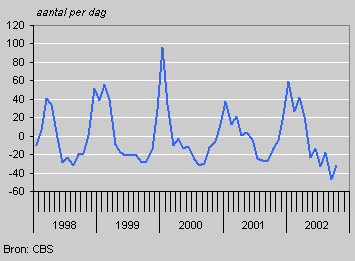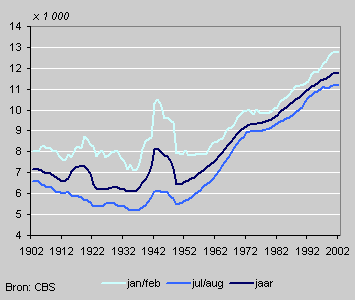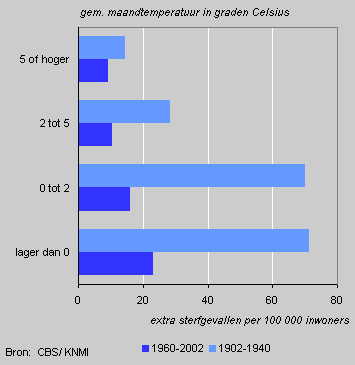More deaths in January and February

Every year, more people die in the winter than in the summer months. The mortality peak is usually in January. In recent years the excess mortality in this month has fluctuated between forty and a hundred people a day.
Difference between observed and expected deaths

January 2000: highest death rate in recent past
The highest excess mortality in the recent past was measured in January 2000. A flu epidemic which lasted from mid December to the end of January led to an extra two thousand deaths, mainly among the elderly. Overall, 14.9 thousand people died in the Netherlands in that month, the second highest monthly number of deaths in the last century. The highest mortality peak was recorded in the so-called winter of starvation in 1944/’45, when a combination of food shortages and severe frost claimed 18,0 thousand lives.
Difference between summer and winter rates smaller
If the tripling of the population in the last century is taken into account, the differences in mortality between summer and winter appear to have diminished in the course of time.
Average number of deaths per month, 1902–2002

Around 1910 the number of deaths in January and February was on average 30 percent higher than in July and August. In the last decade the difference was on average ten percent. The largest difference between the number of deaths in summer and winter was in 1945: there were more than twice as many deaths in the winter of 1944/’45 than in the summer following the liberation of the Netherlands, although the number of deaths that summer was also higher than average.
More deaths as temperature drops
Although a combination of flu and extreme cold will cause the largest excess mortality, without flu a severe winter will also result in above average mortality. This is revealed by comparing extra mortality in January and February with the average daily temperature.
Excess mortality in January and February, by average monthly temperature

This comparison also shows that the effect of extreme cold has diminished strongly in the last century. Before 1940 on average three times as many people died, relatively speaking, on days with a temperature below 0o C as after 1960. It is also interesting to note that severe winters, i.e. winters with average monthly temperatures below freezing, were just as common in the first as in the second half of the twentieth century. The number of mild winters did increase though. Only in 1988 did the average temperature in January and February reach an average of higher than 5o C for the first time. Since then we have had five winters with such mild temperatures.
Joop Garssen